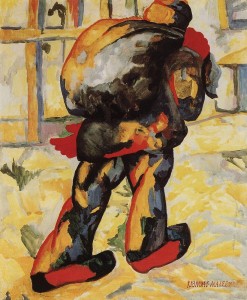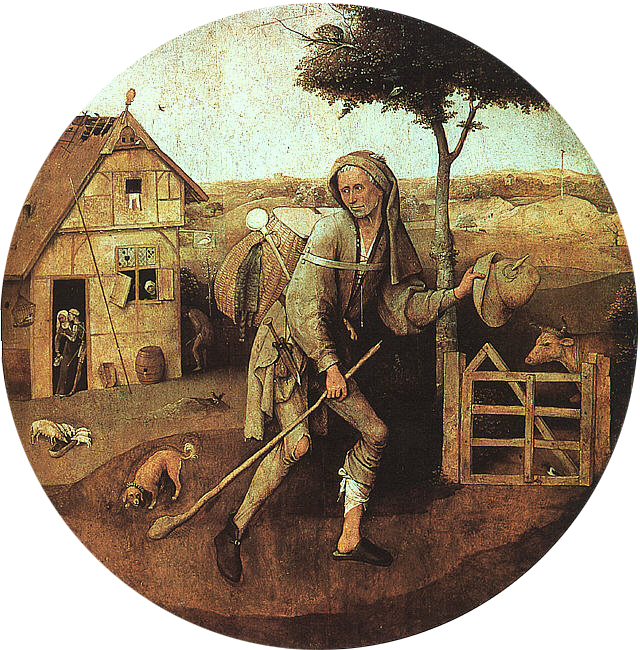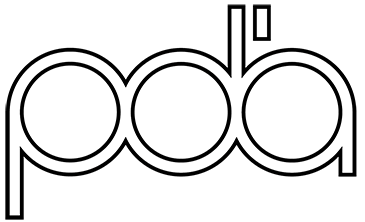CIO’ CHE E’ FISSO E’ ANCHE FERMO, PRIVO DI SVILUPPO, NON VITALE.
(pensiero Zen)
Testo di Sebastian Di Guardo

Kasimir Malevic, The man whit the bag
Vogliamo aprire il sipario su questo numero quattro con qualcosa di più di un titolo e una citazione: vogliamo cominciare con un’incitazione. Certo, può sembrare sorprendente la definizione di cambiamento come sinonimo della vita nel contesto di una religione, com’è il buddismo Zen, perché ogni religione è in sé immutabile.
Siamo anche coscienti che il tema trattato, tradizione e innovazione, è uno dei più dibattuti nell’ambito dell’Architettura, specialmente in territorio accademico. Eppure non vogliamo rinunciarvi, perché lo scopo di Parola d’Arte è riflettere in modo nuovo su ciò che definisce i margini della professione dell’artista, dell’architetto, e in generale di chi immagina e attraverso il suo lavoro genera delle emozioni.
L’Arte e l’Architettura non sono campi del sapere in normale evoluzione, come si può dire della Scienza che si affina senza posa, ma sono piuttosto delle esigenze umane che si nutrono dello spirito del loro tempo, oltre che di un desiderio atavico, che sia estetico o funzionale; e tali esigenze sono in perpetuo divenire, come la società in cui nascono. Lo spazio modellato dall’architettura è quindi per sua natura un tutto fluido e vitale che coagula modi di vivere, e molta vita è contenuta in potenza e nel tempo tra volumi, superfici, sentieri. L’Arte contemporanea, a sua volta, vive dell’interpretazione, della scoperta di un messaggio sotteso. Smettere di parlare del rapporto tra la tradizione e l’innovazione è quindi vano, perché nei nostri pensieri e nelle nostre vite emergono costantemente nuove forme di Architettura e nuove visioni dell’Arte.
Parola d’Arte prende spunto dalle antinomie tra idee tradizionali e innovative ma con un atteggiamento entusiasta. Crediamo fermamente che una sorta di “rinnovamento radicato” sia necessario, perchè l’unico modo per non creare attrito con qualcosa è muoversi in modo univoco con essa. Lo abbiamo fatto fin dal primo numero, “edificare un linguaggio”, quando abbiamo sostenuto una rivoluzione dell’intero “sistema” dell’Arte, e il discorso ha avuto un naturale svolgimento con le edizioni successive.
È emerso che un movimento artistico e una “scuola” d’Architettura davvero contemporanei devono ormai nascere, perchè non è più opportuno sfruttare modelli che abbiamo ereditato dal passato, come il post modernismo o gli stili delle Star Architects, quando la società, i costumi, l’evoluzione del corpo stesso sono cambiati in modo imprevedibile. La resilienza umana del pensiero e delle discipline è l’unica alternativa e resistere risulta pericoloso e straniante.
Affrontando il tema del linguaggio e di un nuovo modello di città abbiamo compreso meglio cosa significa essere “uomini massmediatici”. Certo la società massmediatica (ricordate i terrificanti dirigibili pubblicitari del film Blade Runner?) esercita una forte influenza sull’uomo, la sua arte, i luoghi dove vive la sua quotidianità. I sistemi tecnologici hanno cambiato le nostre vite e per alcuni di noi anche il corpo, integrandolo in senso fisico. Abbiamo ormai constatato l’appiattimento delle differenze culturali e sociali, la globalizzazione della finanza con ricadute ora positive ora negative, e il pericolo dell’insostenibilità ambientale.
Questo si può considerare sufficiente per la costruzione di un pensiero radicato nel presente, un presente nel quale dobbiamo “risvegliarci”.
Spunti nuovi su come attivare un processo rinnovatore, sono giunti già nel numero precedente: rivitalizzare l’obsolescente, perchè nulla può più essere sprecato, e progettare a partire da un nuovo principio, quello delle emozioni. I nostri cinque sensi e il nostro cervello sono stati artificialmente potenziati e integrati e pretendono un qualcosa di più: qualcosa di più delle architetture o opere d’arte create per esaltare il potere economico di una società per azioni, o basate solo sull’idea di sostenibilità ambientale (vera o presunta), o legate a uno stile particolare, eredità dell’ordine architettonico. Siamo ormai abituati ad assorbire un numero impressionante di immagini e suoni. Si tratta in altre parole di esperienze, che sempre più spesso depositiamo in forzieri digitali sociali nella forma di immateriali byte diffusi nell’etere. Almeno questa volta Blade Runner non è stato, per fortuna, buon profeta: presto nessun momento si disperderà nella pioggia.
INNOVATIVE TRADITIONS
WHAT IS FIXED IS ALSO STILL, WITHOUT DEVELOPMENT, NON-VITAL.
(Zen thought)
Text by Sebastian Di Guardo, translations by Laura Dumbrava

Hieronymus Bosch, The traveler, 1494. Oil on panel 71×71 cm. Museum Boymans-van Beuningen, Rotterdam
We want to open the curtain of this fourth issue with something which represents more than a title and quotation: we want to start with an incitement. Obviously, it might seem surprising the definition of change as a synonym of life within a religion as it is the Buddhism Zen because each religion in its self is unchangeable.
We are also aware that the selected theme, tradition and innovation, is one of the most debated in the architecture field, especially in the academic territory.Nevertheless, we do not want to let go of you because the purpose of Parola d’Arte is to reflect, in a modern way, what defines the sides of the artist’s profession, of the architect’s, and generally of whom imagines and through his work generates emotions.
Art and Architecture are not fields of knowledge in a normal evolution, as it can be told about the science which improves without exposure, but they are mostly human exigencies which nourish themselves with the spirit of their time above an atavistic desire, whether esthetical or functional; and such exigencies are in a continuously growth as the society in which they are created.
The space which is shaped by the architecture is therefore, by its nature, a whole fluid and vital which coagulates ways of living and much life is contained within the power and time among volumes, surfaces, trails. Contemporary art, on the other side, lives of interpretation, of discovering a hidden message. To stop talking about the relationship between tradition and innovation is therefore useless because in our thoughts and our lives constantly emerge new forms of architecture and new visions of art.
Parola d’Arte is inspired by contradictions between traditional and innovative ideas but with an enthusiastic attitude. We firmly think that such a thing like “radical renovation” is necessary because the only way not to create friction with something is to move along in a univocal way with it. We have done it since the first issue, “edifying a language”, when we supported a revolution of the entire “system” of arte and the discourse had a natural development with the next editions.
It had been emerged that an artistic movement and a “school” of architecture, contemporary
indeed, must be created by now because it is not opportune anymore to exploit models
which we have inherited from past, such as the post modernism or the styles of the Star Architects because the society, the suits and the body’s itself evolution had changed unpredictably. Human resilience of thought and disciplines is the unique alternative, and withstanding could be dangerous and estranging.
By confronting the theme of language and the new model of city, we have better understood what it means to be “mass media human beings”. Of course, the mass media society (remember the terrifying publicity airships in the Blade Runner film?) exercises a great influence on man, on his art, on his place where he spends his daily life.
The technological systems have changed our lives and for some of us the body too by integrating it in a physical sense. We have observed by now the flattening of the cultural and social differences, the globalization of the finance with positive and negative relapses, and the danger of environmental unsustainability.
This could be considered enough to build a thought rooted in the present, a present in which we need to “wake up again”.
New hints on how to activate a renovator process were already dealt in the last issue: revitalizing the obsolescent because nothing could be more wasted, and starting to project by starting from a new principle, that of emotions. Our five senses and our brain had been artificially strengthened and integrated and they pretend something more: something more than architectures or artworks created in order to exalt the economic power of a society guided by actions or based only on the idea of environmental sustainability (real or presumed) or linked to a particular style as a heritage of the architectonic order.
We got used by now to absorb an impressive number of images and sounds. It deals, in other words, with experiences which we always store them within digital social coffers having the shape of immaterial bytes which are widespread within the ether. At least this time, Blade Runner was not, fortunately, a good prophet: soon no moment shall be dispersed in the rain.
